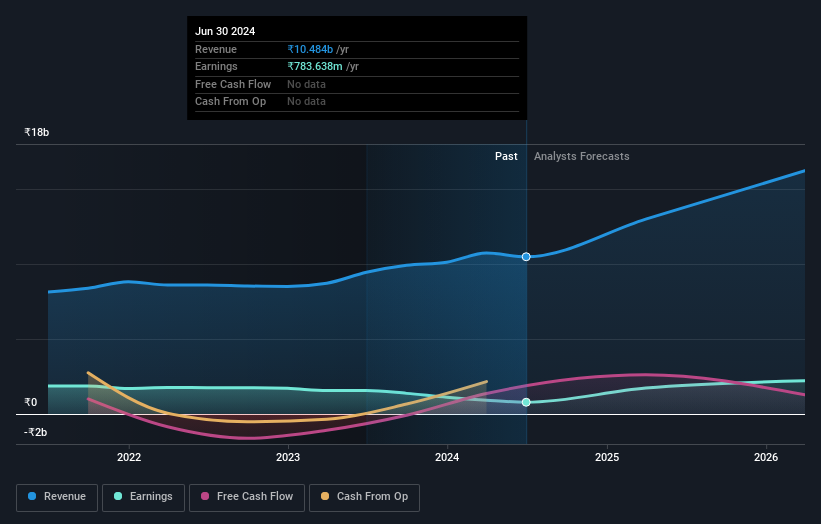- India
- /
- Metals and Mining
- /
- NSEI:MIDHANI
State or government invested in Mishra Dhatu Nigam Limited (NSE:MIDHANI) copped the brunt of last week's ₹6.3b market cap decline
Key Insights
- Significant control over Mishra Dhatu Nigam by state or government implies that the general public has more power to influence management and governance-related decisions
- 74% of the company is held by a single shareholder (India)
- Past performance of a company along with ownership data serve to give a strong idea about prospects for a business
If you want to know who really controls Mishra Dhatu Nigam Limited (NSE:MIDHANI), then you'll have to look at the makeup of its share registry. With 74% stake, state or government possess the maximum shares in the company. That is, the group stands to benefit the most if the stock rises (or lose the most if there is a downturn).
And following last week's 9.0% decline in share price, state or government suffered the most losses.
Let's take a closer look to see what the different types of shareholders can tell us about Mishra Dhatu Nigam.
View our latest analysis for Mishra Dhatu Nigam

What Does The Institutional Ownership Tell Us About Mishra Dhatu Nigam?
Institutional investors commonly compare their own returns to the returns of a commonly followed index. So they generally do consider buying larger companies that are included in the relevant benchmark index.
As you can see, institutional investors have a fair amount of stake in Mishra Dhatu Nigam. This can indicate that the company has a certain degree of credibility in the investment community. However, it is best to be wary of relying on the supposed validation that comes with institutional investors. They too, get it wrong sometimes. If multiple institutions change their view on a stock at the same time, you could see the share price drop fast. It's therefore worth looking at Mishra Dhatu Nigam's earnings history below. Of course, the future is what really matters.

Hedge funds don't have many shares in Mishra Dhatu Nigam. India is currently the largest shareholder, with 74% of shares outstanding. This implies that they have majority interest control of the future of the company. For context, the second largest shareholder holds about 4.5% of the shares outstanding, followed by an ownership of 1.6% by the third-largest shareholder.
While it makes sense to study institutional ownership data for a company, it also makes sense to study analyst sentiments to know which way the wind is blowing. There is some analyst coverage of the stock, but it could still become more well known, with time.
Insider Ownership Of Mishra Dhatu Nigam
While the precise definition of an insider can be subjective, almost everyone considers board members to be insiders. The company management answer to the board and the latter should represent the interests of shareholders. Notably, sometimes top-level managers are on the board themselves.
I generally consider insider ownership to be a good thing. However, on some occasions it makes it more difficult for other shareholders to hold the board accountable for decisions.
We note our data does not show any board members holding shares, personally. Given we are not picking up on insider ownership, we may have missing data. Therefore, it would be interesting to assess the CEO compensation and tenure, here.
General Public Ownership
With a 18% ownership, the general public, mostly comprising of individual investors, have some degree of sway over Mishra Dhatu Nigam. This size of ownership, while considerable, may not be enough to change company policy if the decision is not in sync with other large shareholders.
Next Steps:
It's always worth thinking about the different groups who own shares in a company. But to understand Mishra Dhatu Nigam better, we need to consider many other factors. Consider risks, for instance. Every company has them, and we've spotted 1 warning sign for Mishra Dhatu Nigam you should know about.
If you are like me, you may want to think about whether this company will grow or shrink. Luckily, you can check this free report showing analyst forecasts for its future.
NB: Figures in this article are calculated using data from the last twelve months, which refer to the 12-month period ending on the last date of the month the financial statement is dated. This may not be consistent with full year annual report figures.
New: Manage All Your Stock Portfolios in One Place
We've created the ultimate portfolio companion for stock investors, and it's free.
• Connect an unlimited number of Portfolios and see your total in one currency
• Be alerted to new Warning Signs or Risks via email or mobile
• Track the Fair Value of your stocks
Have feedback on this article? Concerned about the content? Get in touch with us directly. Alternatively, email editorial-team (at) simplywallst.com.
This article by Simply Wall St is general in nature. We provide commentary based on historical data and analyst forecasts only using an unbiased methodology and our articles are not intended to be financial advice. It does not constitute a recommendation to buy or sell any stock, and does not take account of your objectives, or your financial situation. We aim to bring you long-term focused analysis driven by fundamental data. Note that our analysis may not factor in the latest price-sensitive company announcements or qualitative material. Simply Wall St has no position in any stocks mentioned.
About NSEI:MIDHANI
Mishra Dhatu Nigam
Manufactures and sells super alloys, titanium, special purpose steel, and other special metals in India and internationally.
Flawless balance sheet with reasonable growth potential.
Market Insights
Weekly Picks

Solutions by stc: 34% Upside in Saudi's Digital Transformation Leader


The AI Infrastructure Giant Grows Into Its Valuation
Recently Updated Narratives

Perdana Petroleum Berhad is a Zombie Business with a 27.34% Profit Margin and inflation adjusted revenue Business
Many trends acting at the same time


Engineered for Stability. Positioned for Growth.
Popular Narratives


MicroVision will explode future revenue by 380.37% with a vision towards success


NVDA: Expanding AI Demand Will Drive Major Data Center Investments Through 2026



